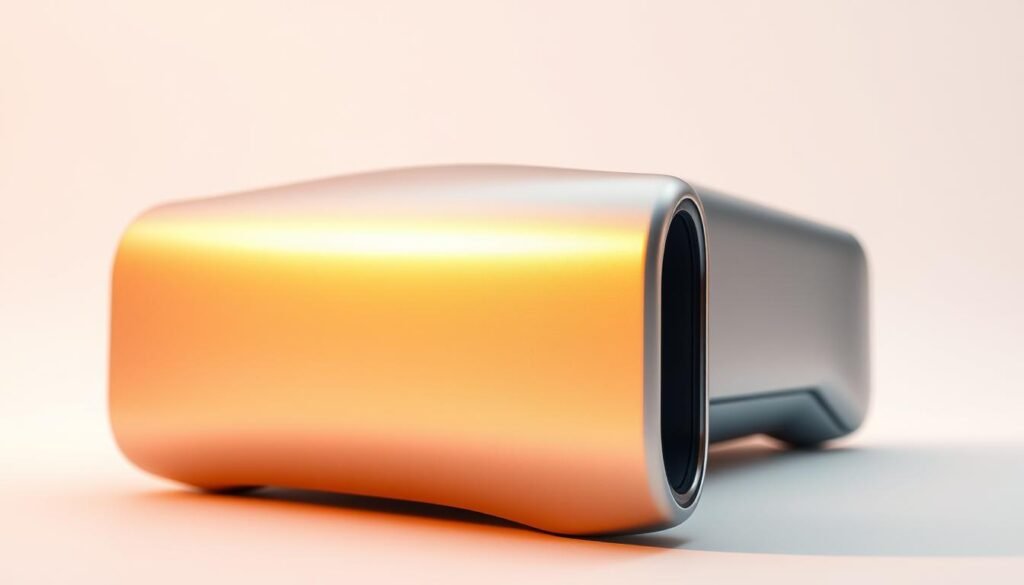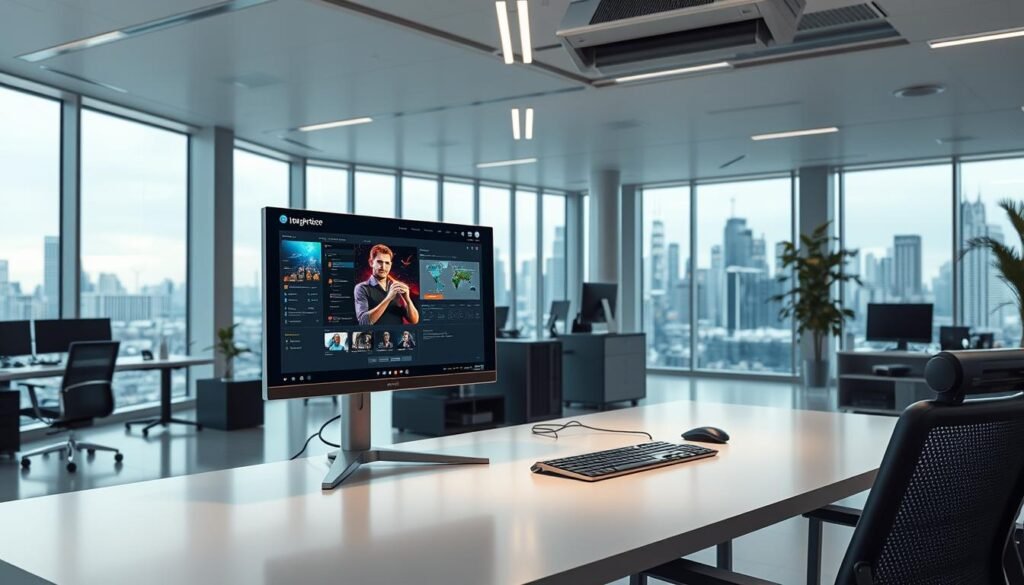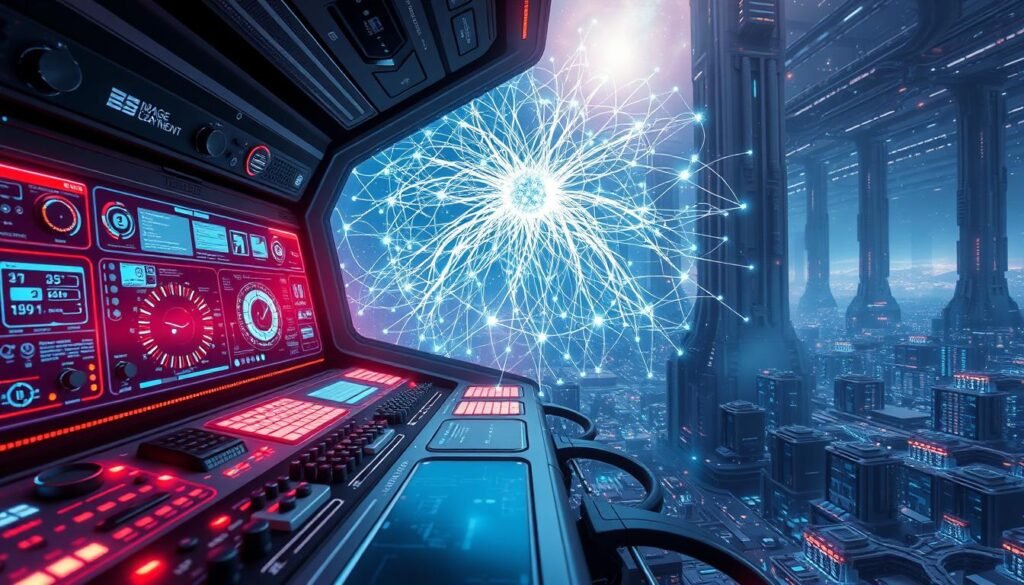Can one tool really replace a studio, stock library, and a designer all at once? This guide looks at that bold claim and helps you pick the right option for your needs.
Define your goal first: whether you want quick social banners, scaled campaign visuals, or polished concept art, the best image generator depends on how you balance quality, speed, rights, and cost.
We preview top creators—GPT-4o, Midjourney, Stable Diffusion, Adobe Firefly, Bing Image Creator, and more—so you can compare models, tools, and real-world results.
What to expect: generated images work great for concepting and marketing but may fall short for ultra-specific brand photography. Licensing, watermarking, and provenance are called out so marketers and small businesses can use assets safely.
This guide is for creators, marketers, and teams who need top results without deep ML expertise. We cover prompt tactics, editing iteration, cost of ownership, and practical time-savers like templates and batch features.
Key Takeaways
- Choose based on goals: speed, quality, rights, and budget.
- Generated visuals excel at concepting and content marketing.
- Check licensing and provenance before commercial use.
- Compare models and tools for text rendering and editability.
- Use presets and batch features to save production time.
- Many platforms offer free tiers—test before you buy.
Why this Product Roundup matters for choosing an ai image generator today
A practical comparison shows which platforms match specific production goals and budgets. This roundup helps readers pick the best option by aligning output, speed, cost, and licensing with real use cases.

User intent and what “best” means
Marketers need brand-safe assets and clear rights for commercial use. Creators chase distinct styles and fidelity. Teams want repeatable workflows, role controls, and collaboration features.
Key evaluation criteria
- Prompt adherence: how faithfully a model follows a prompt and handles complex prompts.
- Text rendering: accuracy for captions, labels, and numbers.
- Editing & iteration: inpainting, variations, and export formats for web and print.
- Platform-level features: moderation, watermarking, provenance, privacy, and storage length.
Tip: Test several platforms with identical prompts to benchmark quality and turnaround before committing to a subscription.
Top picks at a glance: best image generators for different needs
This quick map links top platforms to the tasks they handle best, so you can shortlist fast.

Overall quality and ease of use: GPT-4o (ChatGPT)
Best for general-purpose production: accurate text and numbers, simple chat edits, and a smooth app experience.
Artistic style and textures: Midjourney
Best for cinematic, stylized work with rich textures and color science that designers favor.
Prompt adherence and complex details: Reve Image 1.0
Best for strict prompt fidelity—positional accuracy and multi-element scenes are its strengths.
Accurate text in images: Ideogram
Best for posters, merch, and layouts that require legible, accurate lettering and layout control.
Customization and control: Stable Diffusion and models like FLUX.1
Best for power users who need multiple models available, fine-tuning, and local or hosted workflows.
Workflow and brand integration: Adobe Firefly and Recraft
Best for design teams—tight Photoshop and Express integration plus marketing-ready features.
“Test the same prompt across several platforms to compare adherence, artifacting, and style.”
Quick buying tip: Match one short-listed tool to a single content goal (product mockups, hero banners, social ads) and compare pricing models—credit systems versus subscriptions—before committing.
- Pick the best image generator that fits your primary content goal.
- Run identical prompts across tools to spot differences fast.
- Factor in credits, subscriptions, and team workflow features when choosing.
How an ai image generator works under the hood
Most modern tools start by learning visual language from huge datasets. Models ingest millions or billions of paired captions and photos to learn correlations between words and visual patterns.

From text prompt to pixels: diffusion vs. autoregression
Diffusion models begin with random noise and iteratively denoise that pattern until the output matches the prompt. This approach is fast and flexible for many styles.
Autoregressive models build images token by token. They often improve adherence to complex directions but run slower and cost more compute.
Why models struggle with text and how some beat it
Rendering legible lettering is hard because letters need exact shapes and spacing. Diffusion’s iterative blur can distort letter forms.
Specialized image models or post-processing steps can fix lettering. Some platforms also restrict prompts that name artists to reduce copyright risk.
- Training basics: models learn mappings from text to visual concepts using massive image-text sets.
- Prompt clarity matters: structured prompts cut ambiguity and improve style consistency.
- Model choice matters: some excel at photorealism, others at stylized art; pick to match brand needs.
“Run the same prompt across multiple models to compare fidelity, lighting, and artifacting.”
Practical note: speed and cost vary by architecture, and the app experience often hides those differences. Keep examples and settings consistent when you benchmark tools and generators.
GPT-4o (ChatGPT) image creator: best overall for quality and simplicity
GPT-4o brings conversational image creation into the same chat where you brief and review visuals. That single-flow approach cuts context switching and speeds small-team review cycles.

Strengths: GPT-4o is strong at rendering legible text, numbers, and fine positional detail. It follows feedback well, so you can request targeted edits and get refined results fast.
Limitations: Expect one output per run and slower turnaround than many diffusion-based tools, since GPT-4o uses an autoregressive model for generation.
- Workflow: integrated in ChatGPT for brief-edit-review without switching apps.
- Accuracy: better text rendering and layout fidelity versus many peers.
- Access: free users have limits; ChatGPT Plus ($20/month) eases restrictions.
| Use Case | Best fit | Notes |
|---|---|---|
| Hero images | Quick briefs | Good for clear labels and marketing copy |
| Product mockups | Text-heavy mockups | Accurate numbers and logos |
| Infographic elements | Data labels | Strong text fidelity and provenance controls |
APIs and tools like Zapier enable automations from forms or content calendars. For best results, craft prompts that name subject, style, camera, and lighting, then ask for small edits. A/B test the same prompt in GPT-4o and a diffusion option to judge speed–quality trade-offs.
Midjourney: the art generator for cinematic style and rich image textures
Midjourney stands out for its cinematic palettes and richly textured visuals that artists and designers prize. The platform produces cohesive scenes with deep color work and layered detail that read well at large scale.
Standout look: color, coherence, and style variety
Expect striking moodboards and hero art. Midjourney excels when the goal is dramatic tones, painterly grain, and consistent visual style across frames.
Web app and Discord workflows
Access comes via a dedicated web app for streamlined work or Discord for command-based control and community inspiration. Public galleries boost discovery, but note that content is public by default.
- Visibility: public Explore pages help exposure but may not suit private campaigns.
- Pricing: Basic plans start near $10/month for ~200 creations and include commercial rights.
- Workflow tips: use seed images, style weights, version selection, consistent aspect ratios, and saved prompt templates to maintain brand look.
- Advanced tools: upscalers, variations, and personalization speed iteration for editorial and campaign work.
“Use consistent composition prompts to generate ready-to-crop outputs for web and social.”
Reve Image 1.0: when prompt adherence matters most
When strict spatial rules and multi-element directions matter, Reve Image 1.0 holds up best. This tool is built to follow a clear prompt and honor positional constraints so outputs match briefs closely.
Complex prompts, positional accuracy, and detailed elements: Reve Image 1.0 excels at scenes that list which character holds which object, exact counts of items, or specific relationships between elements. It keeps text placement and legibility better than many peers, making it useful for posters and labeled product shots.
Editing is prompt-driven. You can refine results by rephrasing or adding constraints, but micro-inpainting and fine pixel edits lag behind GPT-4o and Midjourney. Use it when fidelity to instructions matters more than granular retouching.
Credit-based pricing and default four-up generations
Reve gives 100 free credits up front and adds 20 credits per day. Extra packs start at $5 for 500 credits. Each run returns four variations so you can pick the closest match in a single pass.
- Best fit: product diagrams, constrained scene composition, brand-compliant layouts.
- Workflow tip: start with subject, action, setting, and style. Add details incrementally to avoid conflicts.
- Scale tip: keep a prompt library and batch-test rephrasings when adherence is critical.
For teams needing the best image fidelity to specifications, this image model is a solid specialist among image generators and models in the current toolkit.
Ideogram: the image generator that nails text on images
When legible lettering matters, Ideogram 3.0 stands out. Its algorithm preserves letterforms while keeping overall visual quality high. This makes it a solid choice for designs that mix art and copy.
Why text is hard and how Ideogram improves it
Diffusion approaches blur tiny details during denoising. That blurs letters and harms readability.
Ideogram 3.0 uses refinements that lock glyph shapes early, so text stays sharp. The result is cleaner headlines, labels, and packaging copy.
Workflow, batching, and canvas tools
The web app offers a simple sketch-to-edit flow. Use the image editor for quick tweaks, then run variations with new prompts.
- Batch Generator: upload a spreadsheet to create many outputs at once.
- Image-to-image and canvas: remix assets, add text layers, and layout posters or merch.
- Export: pay plans enable full-res downloads for print.
The limited free plan gives 10 credits/week with queue waits. Paid tiers start at $8/month for priority credits and high-res exports.
Use cases: merch, posters, cover art, and social posts with headlines that must read clearly.
“Compare outputs against Midjourney and GPT-4o when text clarity is the top priority.”
Stable Diffusion and models like FLUX.1: control, customization, and local options
Stable Diffusion and its forks give teams deep control over model choice, fine-tuning, and local deployments. The open license lets you run on local or cloud GPUs, tune checkpoints, and build repeatable pipelines.
Open ecosystem: fine-tunes, multiple models, and platform access
Platforms such as NightCafe, Tensor.Art, and Civitai host many pretrained checkpoints, LoRAs, and user recipes. Use multiple models to pick photorealism, line art, or stylized looks. FLUX.1 from Black Forest Labs is a strong alternative available on these platforms.
Trade-offs: setup complexity, content moderation, and version variance
Be aware that running locally demands ops time and GPU cost. Community moderation varies; some hubs host mature or NSFW content. Version quality changes—SD 3.5 and older checkpoints behave differently—so test head-to-head on your briefs.
- For teams: keep model registries, prompt safelists, and moderation filters.
- Cost note: compare platform credits vs. self-hosted GPU and storage expenses.
“Document recipes and settings to make generation reproducible across projects.”
Adobe Firefly and Recraft: image generation for design and brand workflows
For teams that ship branded visuals daily, Firefly and Recraft fold creative generation into design systems. These platforms focus on repeatable assets that match brand rules and speed up production for marketing teams.
Using generation inside Photoshop and Express
Firefly integrates directly with Photoshop and Express, so designers can generate and refine pixels without leaving their layout app. This cuts handoffs and keeps edits in-context.
Design-first features include background replacement, object add/remove, and text effects that map to brand templates and libraries.
Graphic design-first features for social media and marketing
Recraft is web-first and vector-friendly, making it ideal for ads, infographics, and social campaigns. Its free plan offers 50 credits/day; paid tiers start near $12/month.
| Platform | Integration | Free plan | Paid | Best for |
|---|---|---|---|---|
| Adobe Firefly | Photoshop, Express | Limited free credits | $9.99/mo for 2,000 credits | In-context retouching, brand compositing |
| Recraft | Web app, shared libraries | 50 credits/day | $12+/mo for full features | Vector layouts, social ad variants |
Production tips: keep brand palettes, type styles, and templates ready. Use non-destructive layers, masks, and content-aware refinements to finish outputs fast.
Standardize prompts and styles across teams, enable shared libraries and version history, and export correct sizes for each social media platform to reduce manual rework.
Bing Image Creator: free daily fast creations and Microsoft Rewards boosts
Bing Image Creator offers a predictable daily quota that suits fast-turnaround content needs. Free users receive 15 fast creations per day. Those slots replenish automatically each day, so you can plan short campaigns or social posts around the allowance.
Fast vs. standard speeds and daily limits
Fast mode gives priority processing for up to 15 creations per day. After that, the service continues at standard speed for free. Use Microsoft Rewards points to boost speed when you need more fast runs.
Access, storage, and responsible safeguards
Sign-in requires a personal Microsoft Account (MSA). Microsoft Entra ID accounts are not supported and availability varies by region. Generated images remain stored for up to 90 days, with options to clear history via Bing or the Microsoft privacy dashboard.
Managing Rewards boosts and messages
- Use Rewards points to keep fast mode after the daily free allotment.
- Monitor your points balance and boost settings to avoid unexpected redemptions.
- Expect occasional messages about high volume, boost redemption failures, or max boost limits.
Responsible AI measures include visible watermarks, C2PA content credentials, and automated prompt blocking for harmful requests.
“Bing is a great way to quickly generate images for social media, mockups, and lightweight marketing tasks.”
Plan workflows to use the per day fast allocations for time-sensitive assets and save high-performing prompts for repeat runs.
DeepAI Free Online AI Image Generator: zero sign-up, instant creation
DeepAI is a frictionless starting point for teams that want to test creative ideas fast. No account is required, so you can generate images immediately and iterate on prompts without onboarding delays.
Multiple styles, API access, and commercial-ready usage rights
Style options include photorealistic, watercolor, cyberpunk, fantasy, and minimalist looks. Smart controls help tune lighting, color, and composition quickly.
Practical perks: the REST API lets you connect the tool to internal apps or content workflows. Outputs are public domain, so commercial use is broadly permitted.
Quality and resolution considerations for print and web
Results work well for web use and small prints. Expect softness on large-format prints because higher resolution exports are limited today.
Workarounds include upscaling with external tools or using DeepAI outputs as concept art before committing to final production.
| Feature | Best for | Notes |
|---|---|---|
| No sign-up | Quick testing | Immediate access, low friction |
| Styles & controls | Creative exploration | Lighting, color, composition presets |
| API | Automation | Simple REST endpoints for apps |
| Licensing | Marketing use | Public domain outputs, commercial-ready |
- Be specific about mood, lighting, and subject details to guide the model.
- Use small prompt changes and regenerate to refine composition.
- Reserve DeepAI for blog headers, quick ads, and presentation visuals where speed matters more than pixel density.
Choosing the one best image generator for your use case
Start by defining whether you need photographic realism or a stylized look. That choice narrows which platforms and models available will serve you best.
Photoreal vs. stylized: picking image style and models available
Decide the target image style first. Photoreal work favors models that handle lighting, skin tones, and fine detail.
Stylized work fits models like Midjourney or FLUX.1 that create strong textures and mood.
Editing needs: image editor, inpainting, and iteration speed
Prioritize platforms with robust editors if you will tweak outputs often. Fast inpainting and quick iteration save time when briefs change.
Licensing, commercial rights, and team collaboration
Confirm rights before committing. Check watermarking, C2PA credentials, and commercial terms.
Pick platforms with shared libraries, role controls, and APIs if multiple reviewers must collaborate.
| Decision factor | What to check | Why it matters |
|---|---|---|
| Style | Photoreal vs. stylized | Aligns model choice and final use |
| Editing | Inpainting, editor speed | Reduces rework and time to publish |
| Rights & collaboration | Licenses, provenance, team features | Keeps assets compliant and reusable |
- Map goals to models and tools, test the same text prompt across finalists.
- Score quality, speed, rights, and cost to find the one best pick.
Prompt tactics that consistently generate better AI-generated images
Good prompts make production predictable. Use a clear structure so teams get reliable outputs and waste fewer credits on retries.
Structuring a text prompt
Start with subject and action: name the main object and what it does.
Then add scene, style, and lighting. Finish with camera or lens notes and composition directions.
- Subject — who or what.
- Action — what is happening.
- Scene & mood — location, time of day, feeling.
- Style & materials — colors, textures, and image style.
- Camera — lens, angle, and aspect ratio.
Prompt iteration: quick edits and feedback loops
Change one variable at a time. Compare versions and keep a short log of what improves text, composition, or color.
When available, use image-to-image to lock composition, then refine with a concise text prompt. Ask the tool to fix one issue per pass — for example, hands or typography — and re-evaluate.
“Keep a prompt library for common brand scenes and test across models to learn each tool’s strengths.”
- Segment attributes with commas or line breaks to avoid contradictions.
- Set aspect ratio and resolution up front to reduce cropping later.
- Respect ethical guardrails: avoid copyrighted names; describe styles generically when needed.
Business use cases: a great way to generate images for marketing and ops
Brands can quickly produce campaign-ready visuals that match weekly content plans and ad tests. This approach saves time and keeps teams aligned on creative direction.
Social media visuals, hero images, and campaign storyboards
High-impact scenarios include social media content calendars, hero art for landing pages, and storyboard frames for video concepts. Use templates to keep a consistent style across channels.
Generate variations for A/B testing to boost click-through rates on ads and emails. Draft prompts internally, then hand off refined briefs to designers for final polish.
Brand-safe workflows, content provenance, and disclosure
Best practice: track provenance, retain metadata, and be clear about when assets are ai-generated images. Maintain watermark awareness and disclose use where required.
- Centralize assets and approvals in collaboration tools.
- Keep a prompt library, brand lexicon, and rights checklist for every asset.
- Use templates for recurring formats to cut production time and maintain cohesion.
Operational uses include internal training visuals, documentation art, and presentation graphics. These practical applications show that generated images are a great way to augment creative bandwidth—not replace photographers or illustrators.
“Track performance: tie creatives to engagement metrics to refine future prompts and style choices.”
- Map campaign goals to models and an image creator that fits the brief.
- Run multivariate tests and document what works.
- Maintain governance to streamline compliance and speed delivery.
Conclusion
Conclusion
Wrap up with a short pilot that benchmarks quality, speed, rights, and workflow fit. Test two or three finalists with the same prompts, then score outputs for fidelity, edit speed, and export needs.
For quick clarity: GPT-4o wins for simplicity and text accuracy, Midjourney for cinematic style, Reve for strict adherence, Ideogram for text-on-asset clarity, and Stable Diffusion or models like FLUX.1 for deep control. Adobe Firefly and Recraft plug directly into brand workflows.
Factor governance into any rollout: check licensing, watermarking, provenance, and retention before scaling. Start with one pilot campaign, document learnings, then expand.
Practical next step: shortlist 2–3 tools this week, run standardized tests, and combine platforms—ideate in one tool and finalize in another—to ship better visuals faster and at lower cost. With disciplined testing and smart prompts, you can scale confidently.



